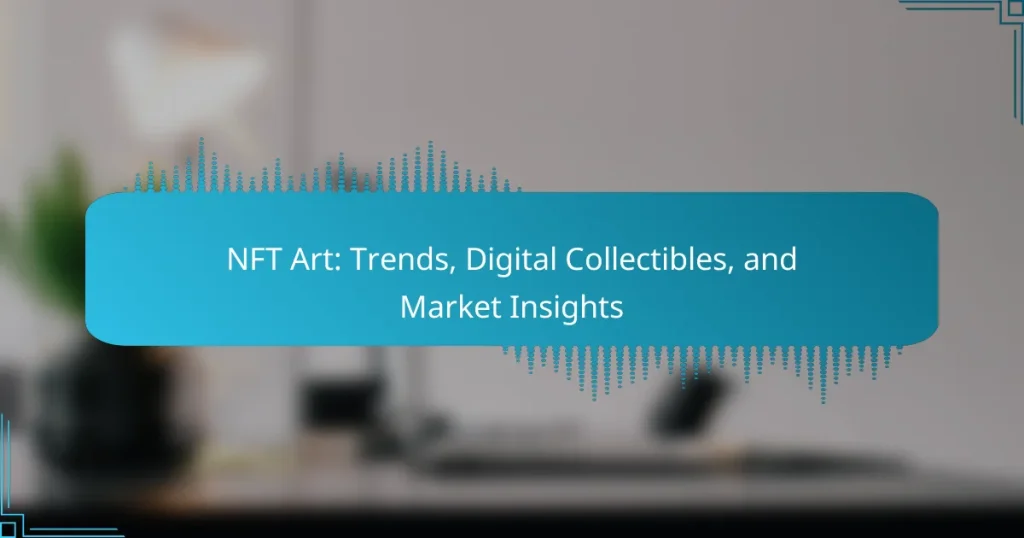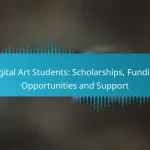The NFT art market is rapidly evolving, showcasing a unique blend of technology and creativity. Current trends highlight sustainability, generative art, and collaborations with traditional artists, while the growing interest in digital collectibles fuels market expansion. For those looking to engage with this vibrant space, understanding the purchasing process and market dynamics is essential for navigating the opportunities it presents.
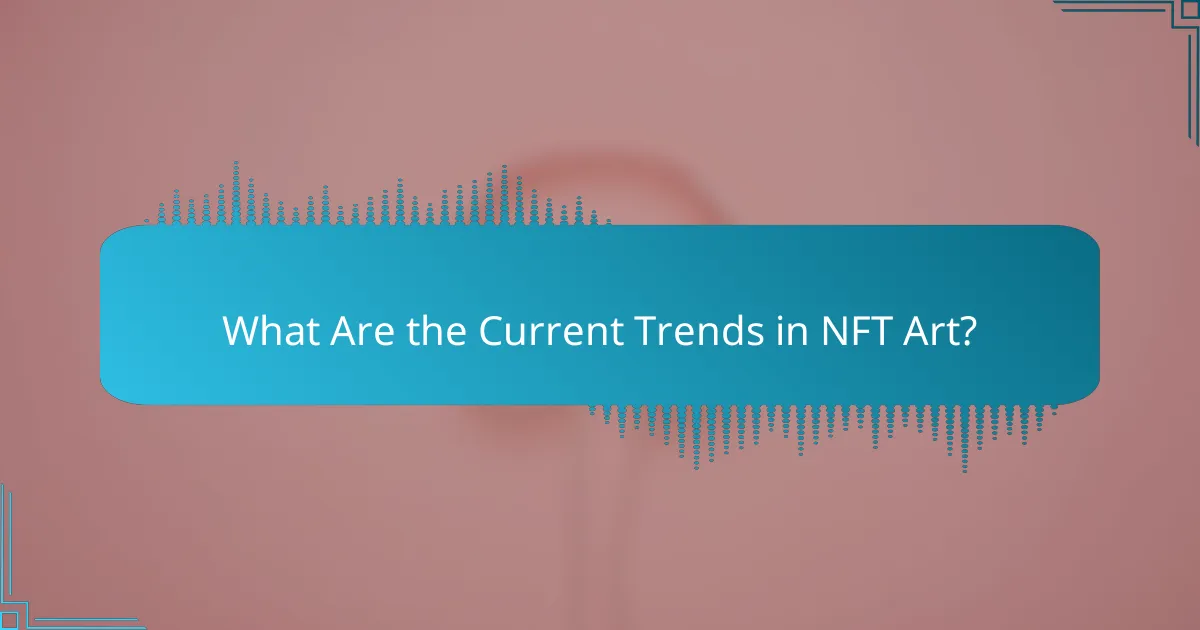
What Are the Current Trends in NFT Art?
The current trends in NFT art reflect a dynamic landscape where technology and creativity intersect. Key developments include a focus on sustainability, the rise of generative art, integration with virtual reality, collaborations with traditional artists, and an expansion into gaming.
Increased focus on sustainability
Sustainability has become a significant concern in the NFT art space, with many creators and platforms seeking eco-friendly alternatives. Artists are exploring blockchain technologies that use less energy, such as proof-of-stake systems, to minimize their carbon footprint.
Some platforms are even committing to carbon offsetting initiatives, allowing artists to contribute to environmental causes while engaging in the NFT market. This shift not only appeals to environmentally conscious buyers but also enhances the overall reputation of the NFT community.
Rise of generative art
Generative art is gaining traction as artists leverage algorithms and artificial intelligence to create unique pieces. This trend allows for the production of art that evolves and changes, offering collectors one-of-a-kind digital assets that are not easily replicated.
Platforms like Art Blocks have popularized this concept, enabling artists to programmatically generate artworks that are minted as NFTs. Collectors are increasingly drawn to these pieces due to their innovative nature and the element of surprise in each creation.
Integration with virtual reality
The integration of NFT art with virtual reality (VR) is transforming how art is experienced. Artists are creating immersive environments where collectors can showcase their NFTs in virtual galleries, enhancing the viewing experience.
This trend not only provides a new dimension to digital art but also allows for interactive experiences, where viewers can engage with the artwork in ways that traditional mediums cannot offer. As VR technology becomes more accessible, this integration is expected to grow significantly.
Collaborations with traditional artists
Collaborations between NFT artists and traditional artists are becoming more common, bridging the gap between physical and digital art. These partnerships often result in unique pieces that combine traditional techniques with digital formats, appealing to a broader audience.
Such collaborations can enhance the legitimacy of NFTs in the art world, as established artists bring their following and credibility to the digital space. This trend not only diversifies the NFT market but also fosters innovation in artistic expression.
Expansion into gaming
The gaming industry is increasingly embracing NFTs, allowing players to own, trade, and sell in-game assets as digital collectibles. This trend is reshaping the gaming landscape, where players can have true ownership of their items, enhancing the overall gaming experience.
Games like Axie Infinity and Decentraland exemplify this integration, offering players opportunities to earn real-world value through their gameplay. As the gaming sector continues to grow, the incorporation of NFTs is likely to expand, creating new revenue streams for developers and players alike.
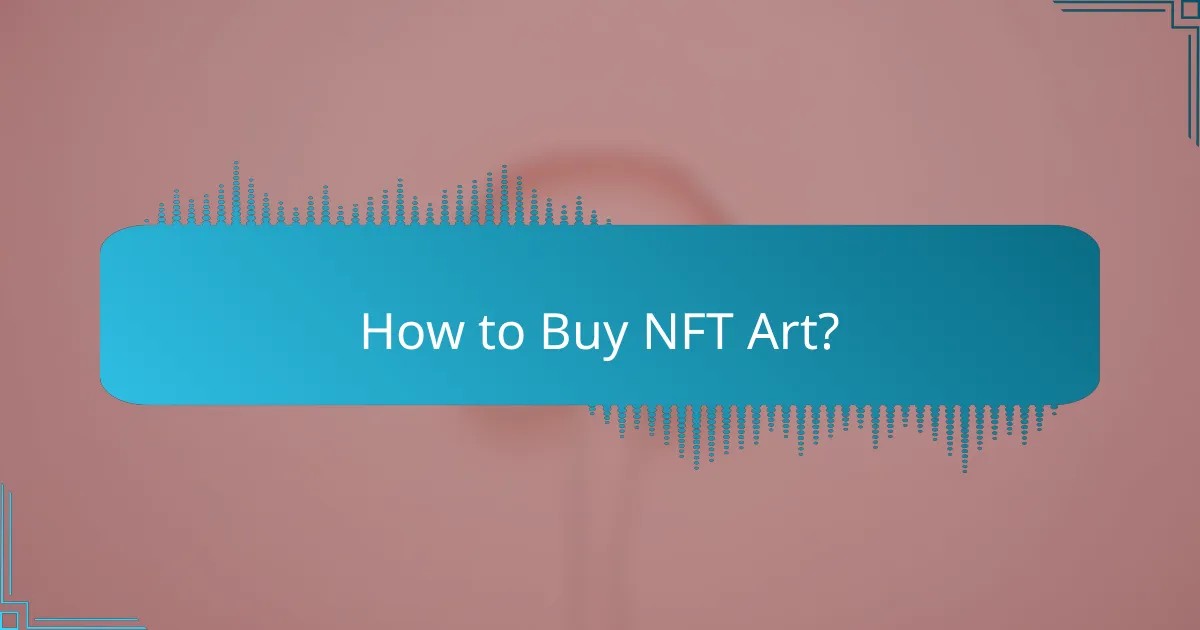
How to Buy NFT Art?
To buy NFT art, you need to choose a marketplace, set up a digital wallet, and understand the associated costs. The process involves selecting an NFT, making a purchase using cryptocurrency, and ensuring your digital assets are securely stored.
Using platforms like OpenSea
OpenSea is one of the largest NFT marketplaces, allowing users to browse, buy, and sell digital art. To purchase art on OpenSea, create an account, connect your digital wallet, and explore various collections. You can filter by price, category, or popularity to find art that suits your taste.
Once you find an NFT you want to buy, simply click on it, review the details, and proceed with the purchase. Transactions are typically completed using Ethereum (ETH), so ensure you have sufficient funds in your wallet.
Understanding gas fees
Gas fees are transaction costs paid to miners on the Ethereum network, which can vary significantly based on network congestion. When buying NFT art, these fees can add a substantial amount to your total cost, often ranging from a few dollars to several hundred dollars.
To minimize gas fees, consider purchasing during off-peak hours when network activity is lower. Some platforms also offer options to set a maximum gas fee, allowing you to control your spending better.
Wallet setup and security
Setting up a digital wallet is crucial for buying NFT art, as it stores your cryptocurrencies and NFTs. Popular wallets include MetaMask, Coinbase Wallet, and Trust Wallet, each offering different features and security levels.
Ensure your wallet is secure by enabling two-factor authentication and keeping your recovery phrases private. Regularly update your wallet software and be cautious of phishing attempts to protect your digital assets.

What Are the Key Market Insights for NFT Art?
The NFT art market has experienced significant growth, driven by increased interest in digital collectibles and unique ownership. Understanding market insights can help both creators and collectors navigate this evolving landscape effectively.
Market growth statistics
The NFT art market has seen explosive growth, with sales reaching billions of dollars in recent years. Reports indicate that the market has expanded by several hundred percent annually, reflecting a surge in both interest and investment. This trend suggests that NFT art is becoming a mainstream asset class.
Key platforms like OpenSea and Rarible have facilitated this growth, enabling artists to reach global audiences. The rise of blockchain technology has also contributed to the market’s expansion by ensuring authenticity and provenance.
Demographic trends of buyers
Buyers of NFT art are primarily younger, tech-savvy individuals, often aged between 18 and 35. This demographic is drawn to the uniqueness and investment potential of digital collectibles. Additionally, many buyers are motivated by a desire to support artists directly through blockchain platforms.
Geographically, interest in NFT art is widespread, with significant markets in North America, Europe, and parts of Asia. However, cultural factors can influence purchasing behavior, with some regions showing preference for specific styles or types of digital art.
Top-selling NFT artists
Some of the top-selling NFT artists include Beeple, Pak, and XCOPY, who have made headlines for their record-breaking sales. Beeple’s “Everydays: The First 5000 Days” sold for over $69 million, showcasing the potential for high-value transactions in the NFT space.
Emerging artists are also finding success, often leveraging social media to build a following and market their work. Platforms like Foundation and SuperRare provide opportunities for new talent to enter the market and gain visibility among collectors.
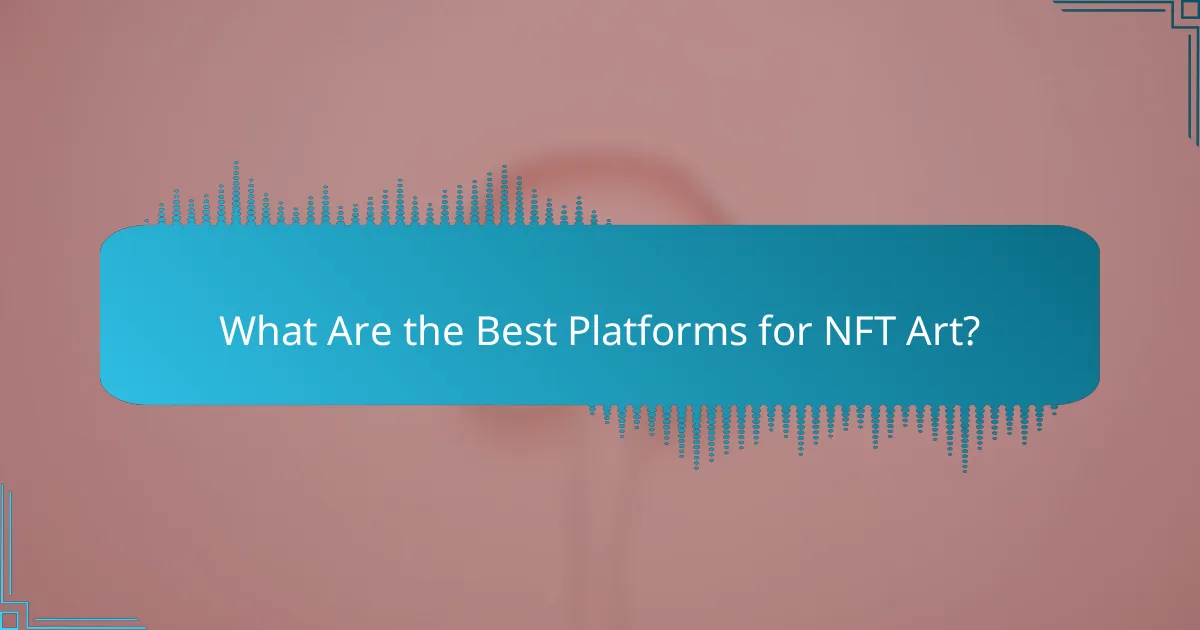
What Are the Best Platforms for NFT Art?
The best platforms for NFT art include OpenSea, Rarible, and Nifty Gateway, each catering to different needs and preferences in the digital collectibles market. These platforms vary in their features, community engagement, and types of art available, making it essential to choose one that aligns with your goals as a creator or collector.
OpenSea for diverse collections
OpenSea is the largest NFT marketplace, offering a wide range of digital collectibles, including art, music, and virtual real estate. It supports various blockchain standards, primarily Ethereum, which allows for a diverse array of NFTs from different creators.
When using OpenSea, consider the gas fees associated with transactions, which can fluctuate significantly. It’s advisable to monitor these costs, especially during peak times, as they can impact your overall investment. Additionally, the platform’s user-friendly interface makes it easy for newcomers to navigate and explore various collections.
Rarible for community-driven sales
Rarible stands out for its community-centric approach, allowing users to create, buy, and sell NFTs while participating in governance through its RARI token. This platform emphasizes user engagement, enabling creators to set their own royalties and engage directly with their audience.
One key feature of Rarible is its focus on decentralized governance, which means that decisions about platform changes are made collectively by the community. This can be appealing for artists looking for a more democratic environment. However, keep in mind that the platform may have a steeper learning curve for those unfamiliar with decentralized finance (DeFi) concepts.
Nifty Gateway for exclusive drops
Nifty Gateway is known for hosting exclusive NFT drops from well-known artists and brands, making it a prime choice for collectors seeking unique pieces. The platform operates on a fiat payment system, allowing users to purchase NFTs using credit cards, which lowers the barrier for entry.
Collectors should be aware that Nifty Gateway often has limited-time drops, creating a sense of urgency. It’s essential to stay updated on upcoming releases and be prepared to act quickly, as popular items can sell out within minutes. Additionally, the platform’s curated approach ensures a high-quality selection of art, appealing to serious collectors.
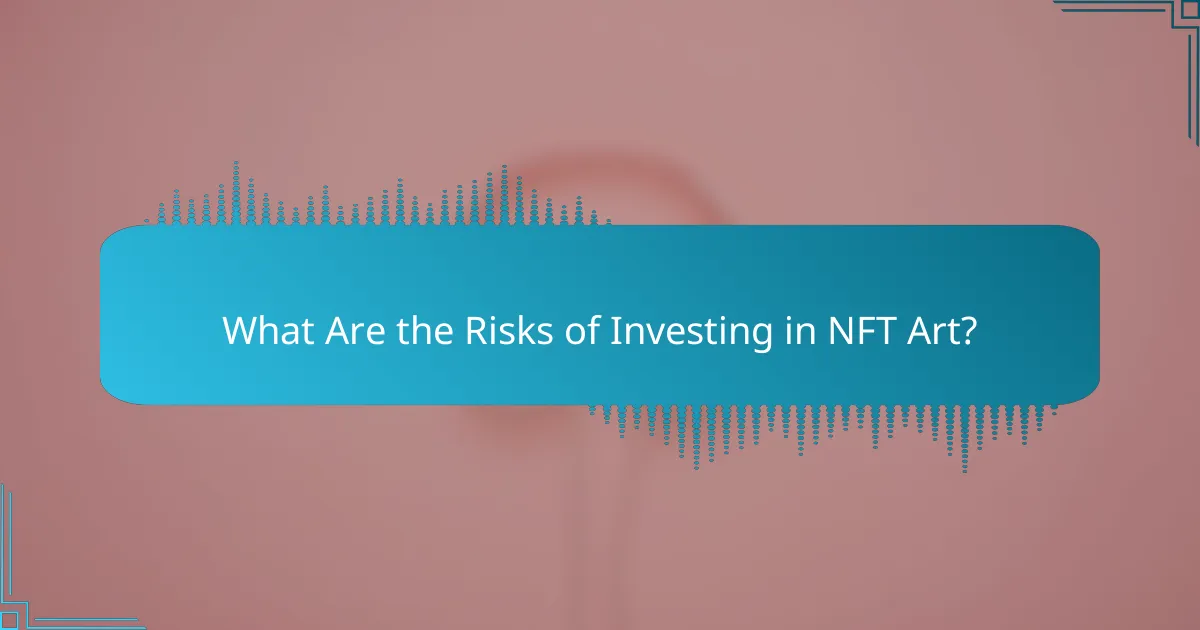
What Are the Risks of Investing in NFT Art?
Investing in NFT art carries several risks, including market volatility and intellectual property concerns. Understanding these risks is crucial for potential investors to make informed decisions.
Market volatility
The NFT art market is known for its significant price fluctuations, which can be influenced by trends, demand, and overall market sentiment. Prices can soar to high levels but may also drop sharply, leading to potential losses for investors.
For example, a popular NFT artwork might sell for hundreds of thousands of dollars one month and then struggle to find buyers at a fraction of that price shortly after. Investors should be prepared for this unpredictability and consider their risk tolerance before entering the market.
Intellectual property concerns
Intellectual property issues can arise when purchasing NFT art, particularly regarding ownership rights and copyright. Buyers may assume they own the artwork outright, but this is not always the case, as the original creator may retain certain rights.
It’s essential to verify the terms of the NFT and understand what rights are included with the purchase. For instance, some NFTs grant only the right to display the artwork, while others may allow for commercial use. Investors should do their due diligence to avoid potential legal disputes or misunderstandings.
